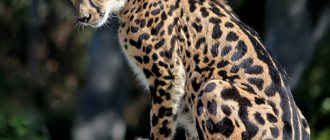One of the most amazing representatives of the cat family. This small cat - about the size of a house cat - can hang from a branch using just one paw and can turn 180° on its hind legs to run up and down trees, much like a squirrel. She also knows how to call monkeys with her voice! I propose to learn more about the most arboreal of all cats.
Long-tailed cat, or margay, sometimes margi (Leopardus wiedii).
Appearance of margi cats
Margay (Felis wiedii)
These mammals grow to a length of about 120 centimeters (including the tail). However, with this body size they weigh only 2.5 to 4 kilograms - relatively little. As already noted, these wild spotted cats have a very long tail, which probably serves as an adaptation for leading an arboreal lifestyle, helping to balance the body when moving along branches.
The ears are round in shape, the limbs are long and slender. And in general, the wild pussy itself is very graceful. The animal's eyes are large and expressive.
The margi's fur ranges from brownish-yellow to light yellow. The entire body is decorated with round spots with black and white streaks along the edges. The color occurs in the form of monochromatic dark spots on a light background. The tail is striped in color, with rather wide transverse stripes of alternately light and dark shades.
The fur of the margay, like no other cat, is similar to the fur of a leopard. It was this feature that led the margay to the trend of extinction.
History of the discovery of the species and subspecies of Margay
The scientific name Felis wiedii was proposed by the Swiss physician and naturalist Heinrich Rudolf Schinz in 1821, while examining a zoological specimen of the animal brought from Brazil. In the name of the most beautiful cat in the world, the scientist reflected his respect for the greatest European zoologist, Prince Maximilian von Wied.
Schintz was mostly involved in natural science and medicine, and was even a professor at the University of Zurich later, and then the keeper of a unique zoological collection. He has translated numerous works in this area, and is also the author of a number of popular articles on representatives of the cat family.
Read about all species in the cat family on the Mister Cat portal.
In 1825, it was Maximilian Von Wied who proposed the name Felis macroura. The famous German explorer, ethnologist and naturalist led an expedition to southeastern Brazil in 1815-1817 and was considered in Europe an undisputed expert on Latin American flora and fauna. He compiled a new scientific description of Margay based on several animals brought from the jungle in the vicinity of the Brazilian Micuri River.
At the same time, the scientist identified a number of main subspecies of the long-legged American cat, discovered by many researchers:
- Leopardus wiedii wiedii. Discovered by Schintz in 1821. It lives in southern Brazil and Paraguay, the northeastern tip of Argentina, and Uruguay.
- Leopardus wiedii glauculus was described by Altfield Thomas in 1903 from an adult specimen found in the Jalisco region of central Mexico.
- Leopardus wiedii vigens – also discovered by Thomson in 1904. The description is based on an adult male found in Igarape-Assu near Parava, Brazil.
- Leopardus wiedii pirrensis was introduced by Edward Alfonso Goldman in 1914, based on an adult female discovered at Cana in eastern Panama.
- Leopardus wiedii amazonicus. Lives in the Amazon (western Brazil, southeastern Peru, southern Colombia, southern Venezuela, eastern Ecuador). Cabrera opened in 1917.
- Leopardus wiedii nicaraguae was described by Joel Asafa Allen in 1919 from an adult male specimen found near the Chinandego Volcano in Nicaragua.
- Leopardus wiedii oaxacensis and yucatanicus introduced by Edward William Nelson and Goldman in 1931. Zoological specimens of an adult male from Cerro San Felipe in Oaxaca and a female from the Yucatan region of Mexico, respectively, are described.
- Leopardus wiedii boliviae and salvinius were discovered in 1941. The first lives in Bolivia, the western part of southern Brazil, the local name for this cat is Ocelittle. And the second is in Chiapas (Mexico), Guatemala, El Salvador.
- Leopardus wiedii cooperi. The subspecies was discovered in 1943. It lives in northeastern Mexico, the state of Nuevo Leon.
Subspecies wiedii wiedii
Subspecies wiedii wiedii
Subspecies wiedii wiedii
Subspecies salvinius
Subspecies yucatanicus
Subspecies glauculus
Subspecies oaxacensis
Subspecies cooperi
Subspecies amazonicus
Subspecies nicaraguae
Subspecies pirrensis
Today, “Leopardus” is used instead of “Felis” in the names of the species and subspecies.
All subspecies of the long-tailed Latin American cat are almost the same size, only slightly different in coloring, which is due to the peculiarities of the natural landscape of different habitats. After all, for a successful hunt, a bright predator must simply merge with nature.
Animal behavior in the wild and its lifestyle
The long-tailed wild cat prefers to live in dense evergreen forests. Where trees grow sparsely, this creature cannot be found. Very often margay runs into coffee plantations. Does she really like coffee? Or is it simply easier for her to find the animals she eats here?
As a rule, Margi cats lead a solitary lifestyle, forming pairs only for the breeding season, and then only for a short time.
Every second margay kitten does not survive in natural conditions. These cats are not as fertile. A female rarely has more than 2-3 kittens.
The margay cat is an arboreal animal and is very well adapted to jumping and climbing tree branches. It hunts at night and rests during the day, climbing into a cave or on a high tree branch. When hunting, it prefers to attack from ambush, disarming the prey with surprise.
Number of margay species
The long-tailed wild cat is on the verge of extinction. This is due to the fact that thick, soft and beautiful fur of wild color is highly sought after on the black market. Another reason for the threat of extinction of margays is the deforestation of tropical forests. Local residents of South America sometimes domesticate these cats and keep them as pets. Thanks to this, there is a chance to preserve part of the gene pool.
The long-tailed margay cat is listed as Near Threatened on the IUCN Red List of Threatened Species. According to interstate agreements, hunting and trade in products made from these cats is prohibited.
Video: two wild cats play in the presence of people
I believe that if science advances, there will be a chance to save more animals. For example, there was already the practice of cloning animals. In 2003, a domestic cat was cloned in Texas on a commercial basis. A woman ordered a clone of her deceased Maine Coon named Nikki for $50,000. As a result of cloning, a kitten appeared exactly like its predecessor. It was noted that the little clone inherited the character of Nikki Sr.
The margay or long-tailed cat is an American wild cat that is small in size but has long legs and a tail. Margai have a number of physiological characteristics necessary for survival in the wild. This predator feeds on small animals and plants, can imitate different sounds and can climb down a tree upside down. The margay is listed in the International Red Book as a species close to vulnerable. However, such a predator can be tamed, but for this it is necessary to provide conditions close to natural ones. It is very difficult to buy a long-tailed cat legally.
Reproduction of Margai
Margay is an excellent hunter.
Climbing trees is the strong point of this wild cat. During the mating season, margay cats form pairs, sometimes they last until birth. A fertilized female marga bears future kittens for about 80 days. Before the onset of lambing, the males leave the female and no longer participate in “family life.”
The female independently arranges a place for childbirth. Usually, it is located in dense foliage, away from the prying eyes of its “neighbors” in the forest. A female marga gives birth to 1 – 2 kittens. They are blind and weigh about 200 grams. Within a week or two, the babies begin to see clearly, and after a couple of months, they go hunting with their mother.
Puberty occurs at 1–2 years. Margs live in the wild for about 10 years.
Ecology of the long-tailed cat Margay.
Margas are the true masters of the upper tiers of trees, thanks to their wide soft paws and movable toes, which allow them to calmly hang on branches, holding on only with their hind paw. If a cat falls down, it only needs to grab onto any branch with one paw, pull itself up and calmly continue its path along the upper floors of the forest. The ankles of the long-tailed cat are designed in such a way that they allow the paw to rotate 180°, giving it the ability to turn in the opposite direction even on a very narrow branch. So, unlike domestic cats, they don’t have to sit in a tree for hours, calling on the whole neighborhood for help.
Margay can hang calmly on one leg. Or some other way 
The extremely long tail acts as a balancer, especially when jumping from tree to tree. And he is a master at jumping: Margi jumps of up to 6 meters vertically and 9 meters horizontally have been noted! Unlike most cats, the margay climbs down the tree slowly, head first.
Margays are predominantly nocturnal, as evidenced by their very large eyes. The diet mainly consists of birds and reptiles. Less often, margay includes opossums, guinea pigs, rats, small monkeys and even (very rarely) fruits in its menu.
Margay on the hunt
Margas are so dexterous and courageous that they sometimes successfully attack even small primates, something that even a larger ocelot cannot do.
In 2005, scientists discovered that these cats can make sounds that imitate the calling calls of a baby tamarin monkey. Although the quality of this imitation left much to be desired, it was quite enough to attract the curious monkeys feeding nearby.
The margay cat can deceive a tamarin with its voice
Does the wild cat of Latin America have enemies?
Wild margay hunts small rodents, birds, and is not averse to feasting on the eggs in the nest.
The researchers did not find direct enemies among the fauna. It is believed that the main exterminator of these animals is man. For the sake of beautiful and thick fur, people mercilessly kill these rare creatures, although the natural mortality rate among offspring already reaches about 50%.
All these circumstances pose a threat to the reduction of the margay population in its habitat. We can only hope that these beautiful creatures will still be taken under protection, because every species of animal on our planet is a value given to us by nature, which we must protect!
Preserving this animal is a difficult task that all governments in South America must address, where the level of poaching is breaking all imaginable records.
If you find an error, please select a piece of text and press Ctrl+Enter.
Life in captivity
Despite its cute appearance, the margay is still a predator, so it is difficult for him to adapt to home life. If there is a small animal in the house, then the margai will definitely feast on it. Even a dog can suffer from the teeth and claws of this cat. Therefore, representatives of this species are most often found in zoos. This animal can also be legally purchased from a specialized nursery. Its price is about $20 thousand. Fortunately, margays reproduce well in captivity.
If you take a margay as a kitten and raise it correctly, then it will not attack people as an adult.
The necessary conditions
The place where the margay lives must be surrounded by a fence. If you choose a private home, then all windows and doors should be covered with bars. Such precautions are due to the fact that the animal may leave home and not return, which is very dangerous for its health, especially in cold regions. In places with a relatively warm and humid climate, the animal can live in an enclosure covered with high mesh. It should have a miniature house where the cat can sleep at night. If it is not there, then you will have to provide the predator with an overnight stay in the house.
In regions with a warm and humid climate, margay can live in an enclosure
Trees should be located in the blinking enclosure. It would be good if there were green spaces nearby, next to which the animal would feel as if it were in its natural environment.
The cat's diet should include meat and small bones:
- Chicken;
- beef;
- feed mice.
Offal can also be added to food. It is recommended to add vitamins to them, which the veterinarian will tell you about.
With the right actions of the owner, the long-tailed cat will very soon be tamed. However, she still won’t be able to sit on them for long.
A friend told me that while she was traveling abroad, she stopped in Peru. Many residents there keep long-tailed cats at home. But it’s quite difficult to call them tamed, since every now and then they try to bite their owners - that’s just their “way of communication.” Of course, they are affectionate, but only as much as their wild nature allows. These animals are quite beautiful, as my friend was able to see with her own eyes. But her pussy still didn’t let her stroke herself - she tried to bite. She feeds exclusively on raw meat; sometimes she definitely needs to eat greens (grass or leaves).
Features of behavior
The animal can spend its free time from hunting on tree branches.
The long-tailed cat spends most of its time alone, usually in trees. Margay can hunt, relax and spend his leisure time here. It makes its den in a hollow tree or a forgotten hole. The cat is flexible, so it can easily jump over branches, even over long distances. Moves quickly up and down the trunk. If a margay jumps from a height, it always lands on the ground on all 4 paws. By nature she is endowed with excellent hearing, vision, orientation in dark spaces and, more often, forests. The personal territory of a long-haired cat is 13-16 square kilometers in area, it is marked with urine, marks in the form of scratches on the bark and is fiercely guarded by the animal itself. Males show favor to the female sex only during the period of courtship games and mating, and other males are kicked out of their own territory with fights.
Cats hunt at night and return to the den in the morning. They track and watch their prey carefully until the right opportunity to attack arises.
Description and characteristics of the breed
The margay resembles an ocelot in appearance.
Representatives of the margay breed come from South America. This is a rare animal on the verge of extinction.
The long-tailed cat was officially included in the Red Book, prohibiting hunting for it.
Previously, these animals often became victims of poachers because of their luxurious fur.
Margays belong to the tiger family. Despite their miniature build, these animals are true predators. The height of an adult representative of this breed is about 30 cm, and the weight category is about 2.5-4 kg. Long-tailed cats are distinguished by a small head and huge, bright eyes of a dark yellow, golden color.
The animal has gorgeous thick, soft and shiny, although rather short, fur . color can be brown or grayish-red with transverse spots and original patterns. A luxurious long tail , making up 4/7 of the length of the body, is decorated with a dark tip, and the upper part of the body has a snow-white or creamy, light shade.
Long and flexible limbs provide margays with the ability to excellently climb trees and hunt. In general, representatives of this breed are distinguished by their dexterity, dexterity and grace.
What to feed
Cat food is definitely not suitable for margays. The long-tailed wildcat requires a natural protein diet that is close to what it would obtain in the wild. Experts recommend feeding margays with offal, food rodents, beef, and chicken.
The meat must be of high quality, raw and not too fatty. For full development and maintenance of health, a long-tailed cat will also require specialized vitamin and mineral supplements.
Find out what other breeds of wild cats exist:
- Chinese cat;
- forest cat;
- Jaguarundi.
Maturation and reproduction
Tree cats reach sexual maturity at 10 months. The mating season for margays lasts all year round. After the process of reproduction and during gestation, the male lives next to the chosen one, waits for the birth, and then leaves the female with the kittens and leaves without taking part in the life of the offspring. Pregnancy in a long-tailed cat lasts 2-2.5 months. The female creates a den in a hole or in a hollow tree, brings foliage there (always dry), and camouflages her hole from attacks by large predators.
1-2 babies are born in a litter. Kittens are born blind. The eyes open after 2 weeks, at the age of 1.5 months the kittens begin to eat adult food and crawl out of the mink for the first time. They continue to feed on mother's milk for 8-9 weeks, after which they eat only solid food. A newborn kitten is gray in color and covered with small dark spots. After a year, the animals acquire the color and size of an adult fauna. At the age of 11-12 months, the young animals leave their mother, begin to attempt independent life and search for uninhabited territories with other predators.
LiveInternetLiveInternet
Quote from TaMaRa_TARANZhina's message
Read in full In your quotation book or community!
Margay - wild cat
Margay (margay or Long-tailed cat ) (lat. Leopardus wiedii or lat. Felis wiedii) is a species of the cat family that lives in the moist, dense evergreen forests of South and Central America down to Mexico. These are Panama, Ecuador, Brazil, Guyana, Uruguay, Belize, northern Colombia, Peru, northern and eastern Paraguay, northern Argentina.
These wild cats are distinguished from their “relatives” by size and proportions, as well as their lifestyle. For example, the margay is very similar to its closest relative, the ocelot, which, moreover, is quite often found in the same place where the margay . It is not difficult to distinguish these cats - the ocelot is noticeably larger, since it prefers to hunt on the ground, and the margay has longer legs and tail, due to life mainly in trees.
The margay, along with the ocelot and oncilla, represents the genus Leopardus, which lives exclusively in the New World.
The large expressive eyes of the margay are in perfect harmony with the colorful woolen outfit of this cat. The margay has a long tail, which is why it is also called a long-tailed cat. Such a tail serves as a balance for this animal when moving along the branches, because the margay spends a lot of time in the trees. The weight of this charming animal ranges from approximately 2 to 5 kg. Despite its small size, the margay is folded quite tightly.
Margay leads a semi-arboreal lifestyle and is active mainly at night, but can also be found during the day. He is an excellent tree climber and can jump from branch to branch like a squirrel. Even from a completely vertical trunk, the margay descends head down. In this he is helped by the special structure of his hind legs, which can rotate almost 180 degrees.
Although the margay is somewhat smaller than the ocelot, it is still significantly larger in size than the domestic cat . Magrays reach up to 1.2 meters in
Margay's prey includes not only birds, rodents, lizards, frogs, but also some small monkeys. It is especially worth noting the acrobatic talents of this animal - the margay is in many ways similar to a squirrel: thanks to its long tail, it can jump from tree to tree, even if they are far enough away, and even go down the trunk upside down: the key to this is the special structure of its hind legs.
Now the margay in the wild is on the verge of extinction - this is due to its fluffy, thick and soft fur, distinguished by its special colors.
However, in some areas of South America, local residents domesticate these long-tailed cats , and keep them instead of domestic cats, so, in any case, some part of the gene pool will be preserved, and the chances of saving this fast, agile and beautiful animal are quite high.
A female margay , as a rule, brings only one cub, less often two. The weight of a newborn kitten is approximately 450 g (sometimes less). This is more than the weight of newborn domestic kittens, although the Margay itself is slightly smaller than the average domestic cat. The lifespan of a margay is about 18 years, but this happens, as a rule, in captivity, where the animal is not in danger.
Keeping margay at home is a very difficult task.
He is well tamed, that is, he will not rush at your throat and will not try to tear out your child’s eyes, as most types of wild cats do when taken into the house.
But the margay is not a domestic ; it has fully formed normal behavior of a wild predator. Those. all small animals in your home are his legal prey. Including dwarf dogs and aquarium fish.
You can even pick up and stroke tamed margays, he won’t tear your face off, and he’ll sit quietly for about two or three minutes. But then he will run away. And, of course, it is advisable for him to have a spacious and beautiful enclosure with branches and tree trunks and a lot of greenery and warm air (this is a tropical cat, not a northern one).
If just keep margi in the house , you need to make sure that there are no small children, and that all windows and doors are covered with a metal mesh and the doors are equipped with transition vestibules. Otherwise, there is no guarantee that the animal will simply not leave the house one fine day (the leaving of the margay from the house means 100% of its death in the first autumn from the cold).
The color of the margay is similar to that of its more powerful relative, the ocelot. The large expressive eyes of the margay are in perfect harmony with the colorful woolen outfit of this cat. The margay has a long tail, which is why it is also called a long-tailed cat. Such a tail serves as a balance for this animal when moving along the branches, because the margay spends a lot of time in the trees. The weight of this charming animal ranges from approximately 2 to 5 kg. Despite its small size, the margay is folded quite tightly.
Margi lives in damp, dense evergreen forests. Does not tolerate sparse woodland or cold. Sometimes she wanders into cocoa or coffee plantations. With the exception of the breeding season, it leads a solitary lifestyle. An individual plot occupies 12-16 km2. Animal areas may partially overlap. Margay is a tree cat. She is excellent at climbing trees and jumping. It goes hunting mainly at night. It searches for its prey under the treetops. Instead of pursuing prey, it prefers to be in ambush and then attack the victim. While hunting in trees, it jumps from branch to branch and, like a squirrel, can even climb down tree trunks upside down. It can easily hang on a tree branch, clinging to it with the claws of just one paw. Jumping from a height, the margay lands on all four legs, due to the special structure of its hind legs. During the daytime, it rests in caves, among dense thickets of vegetation or on tree branches.
It feeds on small mammals living in trees - rats, squirrels, opossums, birds and their eggs. It also eats lizards, frogs and insects. Occasionally eats small primates, porcupines, three-toed sloths, grass and other vegetation.
Margay breeds almost all year round. After mating, the couple remains together until the end of the mating season, until childbirth. During this period, cats sometimes hunt together. Males leave the female before giving birth and do not take part in raising the offspring.
For childbirth, the female chooses a secluded place. Sets up a den in the forest thicket in dense foliage on the trees. Pregnancy lasts about 80 days. The female brings 1-2 blind kittens. The eyes open in the second week. Kittens leave the nest only at two months of age and begin to accompany their mother on hunts. At 8-10 months, kittens become completely independent.
Margays are poached because of their beautiful and thick fur. Sometimes the local population keeps the margay as a domestic cat.
The margay is in danger of extinction as a species throughout its range due to tropical deforestation and poaching.
Population/Conservation Status : Margay is an endangered species throughout its range. Threats to the species: destruction and fragmentation of habitats, poaching. Currently, eleven subspecies of Felis wiedi have been described: F. w. Wiedii - eastern and central Brazil, northern Argentina, F. w. Amazonica - Brazil, F. w. Boliviae - Bolivia, Brazil (Mato Grosso), F. w. cooperi - Mexico (Nuevo Leon), F. w. glacula - Mexico (Sinaloa), F. w. Nicaraguae - Honduras, Costa Rica, F. w. oaxacensis - Mexico (Tamaulipas), F. w. pirrensis - Panama, northern Peru, F. w. Salvinia - Mexico (Chiapas), Guatemala, El Salvador, F. w. Vigens - Orinoco, F. w. Yucatanica - northern Chiapas, northern Guatemala, Yucatan.
Source
Habitats: where can you see?
The animal is distributed throughout Mexico.
The long-tailed cat is found in Mexico, the United States of America, Argentina, and Uruguay. Animals live in forest areas below 1400 meters above sea level. The habitat is considered to be tropical and deciduous forests, savannas with swamps, and plantations where coffee beans are grown. The animal spends most of its free time climbing trees, which is why it was given the name “tree cat.” These predators do not go to areas where there is no vegetation; they avoid areas touched by people, except for coffee plantations, since there are trees there.











